Podcast: Download (Duration: 31:55 — 29.4MB)
Get Notified Of Future Episodes Apple Podcasts | Spotify | Amazon Music | Android | Blubrry | Gaana | TuneIn | Deezer | Anghami | RSS | More
In the episode:
02:19 – A stroke of luck
04:31 – A familiar theme
05:51 – It’s all in the data
08:28 – Google knows best
09:30 – Getting the AI to learn
13:52 – Some useful advice
15:25 – Time to look at those leads
16:56 – Proper time expectation
18:37 – What it lets you do
20:12 – The stuff that doesn’t work
21:49 – When you lack conversion data
24:11 – What competitors are in for
26:44 – Making things seem simple
28:23 – Something to finish on
Keep your marketing timely and impactful with help from James
Transcription
James: James Schramko here. Welcome back to SuperFastBusiness.com. This is Episode 666. And my guest today is Scott Desgrosseillers from Wicked Reports. Welcome.
Scott: Welcome, James. Thanks for having me. Good pronunciation, by the way.
James: Oh, thank you. It’s great to have you back. We had a wonderful Episode number 590, we were talking about the test data that you had collected of $1.5 billion worth of advertising and what that meant. I still refer back to that episode on a regular basis in my coaching, because one of the highlights from that episode for me was just how long it can take for a conversion event to be profitable. It’s a little bit longer than most people would expect. And it it really flew in the face of some of the popular advice about trip wire advertising and self-liquidating offers, etc. So that was a highlight for me.
I’ve continued to use Wicked Reports, and I’m getting great data from it, which is helping drive my business. In fact, just recently, we made some significant changes to my membership based on some of the data that we were getting. And I was also able to reach into the tool and find out why I had such a successful month in the month of April 2019. We had like a four X result, which was phenomenal. And I was able to pinpoint exactly which campaigns, which sources, which attributions were causing that so that I can cherry pick that and do more of the same.
Now, today’s episode is interesting, because we’re talking about some groundbreaking technology that is available that has never been able to be used before, which kind of leans on what I was just talking about, it will be a way for me to further take advantage of advertising campaigns. And it’s got something to do with Google. So I’m going to let you introduce this topic, and I’m looking forward to having a great discussion around this, Scott.
A stroke of luck
Scott: Sure, thanks, James. So through various serendipity, and just hard work and persistence, we were lucky enough to get accepted into Google’s platform API program, which made us one of only 10 tools in Google’s complete ecosystem to get selected into this level, which means we have a dedicated Partner Manager and someone who gets to know your business and see how you can best work with Google. And it just so happened that our Partner Manager, a wonderful lady by the name of Claire Smith, understood attribution very well and realized that we could potentially map our lifetime value based on real leads and sales from the CRM into Google’s algorithm, in a way that was going to allow Google’s power in machine learning to bid for your most likely customers on autopilot.
And I was thrilled by the idea that one, Google understood and was giving us some attention, that’s always nice. We collect all this data, we track it, we measure it, we show it to you, you look at it, there’s a lot of work that goes into just getting to the point where, okay, now you got to make a decision with the data. And sometimes, like you said, you get a four X return, well, that’s awesome. That’s what we want people to have. And enough people have those results, eventually, that they stay and buy and make a lot more money on their Wicked Reports investment, because their marketing campaigns are working. But the idea that that could even take that step out, and that the machine can automatically bid for you based on your real results that are happening in your actual lifetime value, I mean, that’s the holy grail of what I’m trying to do. So the idea I could actually get there this year, with Google’s help and partnership, was, you know, that just changed my whole roadmap. I said, Okay, how do we do this? And so that’s where I came across.
In the process of doing this the past seven months, getting it ready for release, we learned a lot about how these AI algorithms work, what they need to know in order to make you more money, or where they’re insufficient, and you can’t count on them, what to do before the AI will work, all kinds of fun things that I wanted to share with your audience, because I think it’s going to help anyone that’s in Google paid advertising. And if you’re not, or if you tried in the past and haven’t worked out, it’s time to give it another shot.
A familiar theme
James: Yeah, this is a theme I’ve been hearing a little bit, starting back the end of last year, when I was speaking to Mike Rhodes on Episode 607. We were talking about AI, and how Google are really leading the way there. And he was talking about how it’s going to happen slowly, and then it’s going to happen suddenly. So the speed at which things are improving is dramatic. He gave a few contrasting examples at SuperFastBusiness Live 2019 in his presentation, which is available inside the SuperFastBusiness membership for members. He gave some super examples of how the machines are getting really, really, really good at some things. And there’s still a couple of things that they’re not perfect at, and he was able to highlight some of those things. So I’m really curious to see if things have changed, even in that short amount of time. And also, what sort of curve you would place on the point where it would be such a significant advantage to have this that people who don’t have it will almost be doomed.
Scott: That’s getting close. And I actually read that. I like to read the transcripts when I don’t have time to listen. I read that one, yeah, I want to say, like, in January. And he was saying, I think he was saying about how the machines are better a little over 50%, or like, maybe 70% of the time. You need a Mike Rhodes to run your campaign, or if not, you need someone equivalent, or you’re going to be in trouble.
It’s all in the data
Well, now they need less conversion data. Well, let me back that up. So like, the name of the game… The Google machine, to learn, it needs good info told to it in the right way in order for it to be able to help you. And so the way Google knows if it’s working or not, the best way, is if your conversion data is accurate and up to date, and truly represents what you’re trying to do. I recall, you know, learning from various AdWords gurus back in, I was into this stuff like 2011, 2012, and there was all these ways to gamify or try to game the system or hack it. Those hacks are gone. I mean, you can’t hack the facts. You need real conversion data that’s clean and accurate, because all of the bid strategies now are becoming automated. And so, that means they’re going to be running the bids almost whether you like it or not.
And so then you need to be, if you’re accurately informing the machine, when it’s doing well, that makes the machine learn. And then it can look back through all its various signals at what’s in common with the people that are customers, or people that are leads that become customers, in the case of what we just built. And going in there and with our initial alpha set of customers and seeing their conversion windows, and I don’t know, we have like, 400 or so accounts floating around with AdWords that I look at when I was like, speccing this out. And everyone’s conversion data, including my own before – I know this is a mess – was just like, you know, you had a page view for a minute counted or someone hit this URL, it was a goal; or did they reach the shopping cart page was a goal. Well, those aren’t really the accurate conversions you want. They’re just people that back before the tech was good enough, trying to tell Google as best it could, hey, I want to know that this happens so that I can modify the campaigns and bids myself. And now those type of people going to get destroyed, because imagine, you got a machine monitoring real time when things work and it should raise the bid or not or lower it because people aren’t buying. You can’t hire someone that can flip through 1000 keywords or 200 different affinity interests, try and frantically to modify your bids based on how other people are modifying their bids. And instead you just have a machine that’s basically working 24/7, always doing the right thing.
“You just have a machine that’s basically working 24/7, always doing the right thing.”
James: Yeah, it’s a profound change. And I notice even when I log into Google Analytics these days, they’ve got this little right hand column of insights that are really strong. It’s the sort of stuff I used to have to ask a conversion geek to tell me what’s going on with my data. And now Google are getting really good at showing you a picture of that. They call it analytics intelligence. And I imagine some of this is driven by the same brains that that would be working on these campaigns.
Google knows best
Scott: Oh, definitely. And for me, the most striking example of how they’re like, let us handle it is when you create a new campaign, and you pick from a bid strategy, there’s nine strategies. Eight of them are automated. And the only one not automated is manual CPC, which is cost per click, and that one has a bold disclaimer, something to the effect of, you will suffer decreased performance with this strategy. Like, the only one they let you do, they still want to warn you that you’re going to not do as well.
And then there’s a checkbox for, enhance your CPC. And the tool tip over it is like, we’ll use Google algorithms to help occasionally raise or lower your bid if someone’s more likely to convert. So they literally almost don’t even, the one strategy you can do on your own, they don’t fully trust you, they warn you it’s not going to work. And then oh, there’s a checkbox. So we can occasionally override you because we know better than you even when you insist you know better than us. It’s just mind blowing to me that like, that’s how extreme it is.
Getting the AI to learn
James: So what I’m hearing is there’s this insane feedback loop where you make sales, your tool, Wicked Reports, is identifying that data, passing it back to Google and saying, “This is what we want you to learn, how to make these”, and it goes and gets more. And then your tool’s saying “Yes, more of this, keep it coming. This is more information for you to improve and refine your learning process.”
“The hardest thing to do is to find cold traffic that’s eventually going to buy.”
Scott: Yes, and the unique thing we’re doing on top of just telling Google when the sales occur in reporting on them to our customers, is when a click up the funnel creates a new lead, which in my opinion, the hardest thing to do is to find a new lead that buys. Finding cold traffic that’s eventually going to buy is really tough. I mean, getting them on the list is one thing, then converting them’s the next. Or if you have an email list that’s somewhat dead, or you know, like 80% of your list has never bought, and suddenly, some of them start raising their hands for lead magnets, and then eventually buying. That’s all interesting and hard stuff for machine learning to know, because of the lag in a lead becoming a customer is, you know, unfortunately, leads don’t buy right away, generally.
And so what we did was, if a click up your funnel, like let’s say they’re looking for your SuperFastBusiness coaching, and they start out looking, “business coaching Australia”, just maybe a terrible example, but just go with me. And so then they see something and they join your list, and then they sit there. And then a couple of months later, I don’t know, three, four weeks later, they get hit with a different ad of yours and that’s what makes them actually buy one of your products. And then it’s a recurring product that then it’s going to bill again in 30 days, like one of those SuperFast memberships. So you’ve got a couple of things that are difficult to tell the machine. One is that, hey, membership coaching Australia was really a valuable click, but you didn’t see any revenue from it for, let’s say, six, seven weeks. Well, Google’s not going to trust, no matter what attribution model you pick in there, it’s not going to like and say, oh, we better go bid on more of these membership coaching Australia searches for you, because they don’t see that they turned into revenue. But if now we can hold on to that click, and then when they do the first coaching purchase, we can say hey, you know what? Membership coaching Australia is now worth 100 bucks. And then they recur for another hundred bucks. And I know you have more tier programs in that that are high value. I’m just simplicity. So then all of a sudden, hey, oh, it recurred again, they’re worth 200 bucks, because hey, Google guess what? Membership coaching Australia for this ID, that click, was actually worth 200 bucks. And so then the AI automatically adjusts bids knowing, well, if you want to make four to one, I can now spend a lot more on membership coaching Australia, because it’s actually worth 200 more dollars. And you know, in theory, you have more of those than just one of them. But in a nutshell, that’s how it works. So it’s going to give them mid, top and bottom funnel keywords all get updated with revenue waiting, in a way the machine needs to know about it so that it can adjust bids it otherwise wouldn’t.
James: Yeah, that’s pretty cool. And you’re right. So something that just happened to me was an email campaign around a change in my membership, which generated a lot of sales. And then hopefully, it’s gone and had a look at, of all of those sales, where did they first enter my system? What caused them to be there to be able to receive that email to then convert into a customer? And I’d like to top up, right upstream of that, whichever mountain they came from, to end up in this dam, we should keep tapping that.
Scott: Yeah. That, in its essence, I mean, there’s all kinds of different points of the funnel, different messenger bots, or I want them to watch this video as step four of my funnel out of my eight steps. And those all might be true. But with data, the more signals you look at, the more stressed out you’re going to get, and the less pleasant the experience is, trying to determine how to move forward. So that’s why I like to focus on just a couple of attribution points, because they’re loud at the loudest signals and they’re the easiest to act on and see results. And it’s not saying, you know, other people that have, you know, 10, 15-step funnels aren’t, it’s not important. But the purpose of data, you know, the more points you show people, the trickier things can get. So I reluctantly limited us to five, even though I’d like to show them all. We know them all but this works and people are happy with them. So that’s what we’re sticking with.
Some useful advice
James: What sort of advice would you have for someone who is spending AdWords and has currently got some kind of dashboard, they’re getting some basic inputs? What sort of changes do you think you’ll see over the coming six to 12 months?
Scott: Well, a big thing is target ROAS bidding, and being really cognizant of your ROAS, meaning return on ad spend, and the lag it takes to get that return on ad spend. Because with these automated bid strategies, it’s very similar to the stock market, how all of a sudden these day traders came in with these systems, which cause short term haywire in prices, because all these automated systems are doing the same thing – they’re bidding, buying, and selling and bidding on stocks. Well, that now is going to get more and more rampant in the ad auctions, because you can choose bidding strategies like, try to top this domain every time. So someone might put in, they always want to top your bid. That one’s kind of mind blowing.
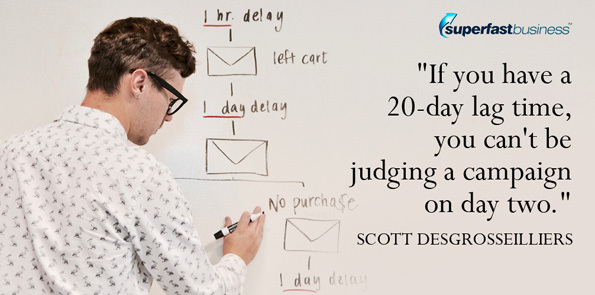 Another one is, I always want to be on the first page no matter what, of results. So keep raising my bid within. And you can set parameters so you don’t go broke, but you know, if you’re in a market against a bigger company with a bigger budget, if you don’t have your numbers down, then you might have a fantastic funnel and ad, and you give up on Google because you don’t seem like it’s working for you. Well, come to find out, you’re just getting crushed by their machine algorithm that has a setting you don’t know about. So it’s going to be important for your dashboards to pull in your bidding strategy, your settings, and then also your ROAS in the lag time. Because if you have a 20-day lag time, you can’t be judging a campaign on day two. I mean, if you’re never closing people that fast, how do you expect the ads to magically find someone that closes in two days?
Another one is, I always want to be on the first page no matter what, of results. So keep raising my bid within. And you can set parameters so you don’t go broke, but you know, if you’re in a market against a bigger company with a bigger budget, if you don’t have your numbers down, then you might have a fantastic funnel and ad, and you give up on Google because you don’t seem like it’s working for you. Well, come to find out, you’re just getting crushed by their machine algorithm that has a setting you don’t know about. So it’s going to be important for your dashboards to pull in your bidding strategy, your settings, and then also your ROAS in the lag time. Because if you have a 20-day lag time, you can’t be judging a campaign on day two. I mean, if you’re never closing people that fast, how do you expect the ads to magically find someone that closes in two days?
Time to look at those leads
James: I was looking at the potential missed opportunity section of my Wicked Reports. And it showed me a campaign that took 62 days from first opt-in to bear fruit. And it was suggesting that I fire that one back up.
“If the leads are buying and you’re not spending, it’s worth knowing about.”
Scott: Yeah, those are common for us. It’s like, if the leads are buying and you’re not spending, it’s worth knowing about. And if it’s a nominal amount, then so be it, don’t bother. But the point it gets to like, it’s always worth alerting you that hey, that idea you had, this month, when you suddenly are getting 10, 20, 30 grand of revenue, and you think it’s just coming from you being viral, well, you’re actually viral. You’ve been in this a long time. But for a lot of businesses, you know, hey, where’s this 30 grand coming from this month? How come these people bought? Well, you know, the advertising you did three months ago, those leads have been hanging around, and now they’re buying because you know, for whatever reason, you’re converting them now. Time to go look. Then that’s the point to look at your last click data to see what’s actually converting these people that have been on your list. But the issue with that, why attribution can get tricky, is those last clicks that actually made people by email great for that last click, that’s not where you found the people. That’s what made them buy. But you’ve got to look differently when you’re trying to determine, where did you find them? And so there’s usually a lag, and it’s not always easy to pay for leads when they’re not buying. I’m the same way, I do the same. Ever run lead gen for a little while? Our cycle’s like, six to eight weeks. And I don’t like paying for eight weeks of leads waiting, it’s psychologically just painful. So you can’t always do it. So missed opportunities for us is just to put it back on the radar, hey, you know what? These leads are finally buying, you might want to do something.
Proper time expectation
James: Well, if it takes 62 days from first opt-in, it takes five days to break even when they kick in. I think of it like, you know, you got the mountains and the different streams contributing to the dam. And it’s like running a trace dye up in the mountains, to see what flows down to the dam. And a lot of people are really only measuring what goes over the dam wall. You know, that’s the obvious point. But it’s pretty hard with lots of different tributaries to track them all and to know what’s going on. But data like that’s really valuable. I have a 450% return on investment for this group of leads now that came originally from Facebook. But I imagine in most businesses that by 62 days, they’ve already said, Hey, turn it off. It’s not working. Because, you know, that will be a common gripe from Facebook ad agencies, their customers think they’re a rainmaker, that they’re going to magically turn $1 into $100, because they’ve seen that other people can run Facebook ads, and they’re instantly rich. It just doesn’t pan out that way in the real world data.
Scott: No, it doesn’t. With Wicked Reports, we put a big thing on our pricing page, this is a 90 day to success. And it’s not that you’re unlikely to learn anything in 90 days, it’s just that, hey, in a quarter you can get set up, you can run your leads through an entire cycle, and then analyze it for one whole cycle. And then you should be quite happy. And that was a departure from when I used to be like, hey, data-driven decision in 14 days, and we’ll pay you to do it. Well, that did give you some decisions, but then if your lead cycles were too long, your buying cycle was too long, it would stress people out. So we had to do away with that one and set the proper longer term expectation, and it’s worked out well for us.
What it lets you do
James: I like with the dashboard, you can keep an eye on stuff. I saw, I made a lot of money on unpaid social in the last 30 days, because I put a little video campaign. It was a one-take shoot, a simple offer. It converted like crazy. But all the work I’d done to get people to be watching my feed in the first place, you know, whether it was a podcast or they’re seeing one of my posts way back. So it’s nice to drill back down and find out, what was the journey like before that event that caused that eventual sale? And you just can’t do that with basic tools and patching together individual systems. So I’m thankful for the ability to do that.
“It’s nice to drill back down and find out, what was the journey like before that event that caused that eventual sale?”
And what I’m hearing is, turning on the AI component, especially with Google, is going to allow your machine to start doing some of the heavy lifting for you. And your role will be to focus on making great products and services that are good for people and get people results, and to support them well, because you’re going to have some growth if you turn on these tools.
Scott: Yeah, and then as a marketer, it’s about the fun stuff of marketing. Well, I mean, the fun stuff for me is the data. But for most marketers, the fun stuff is creating the offers, the landing pages, the hooks, you know, the campaign strategy of what you’re going to show people when, where in terms of once they get into your CRM. That stuff becomes even more of a differentiator, because you need the hooks that get the leads that then buy and then you need the good offer pages. And yeah, an actual offer that’s good. You can’t hack your way anymore. And that’s also a good evolution of marketing that, you know, most of the hacky-type stuff is just going to fade quickly, because it’s just not going to work. If it ever did.
The stuff that doesn’t work
James: I think that’s fantastic. A good brushfire cleans out the forest of all the overgrowth, and you get beautiful new life, you know, springing out from the ground, and it’s a fresh beginning.
Scott: Yes, yes, that’s nice.
James: I never understood how the market put up with so much rubbish since I came online. I didn’t understand it. But it was really just the Wild West, and there were gunslingers in town, and everyone was too scared to come out of the house. But I think even with social media now…
Scott: You don’t know that people are just full of it.
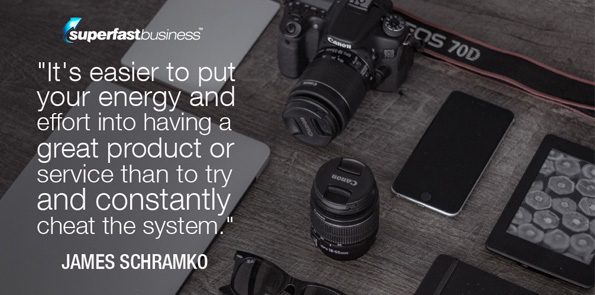 James: Yeah. I’ve seen documentaries like Fyre Festival. And there’s that Theranos, or whatever that big startup was. We’re seeing now, people are falling over when they make outrageous claims, as documentaries are busting down the doors on the tactics of other businesses. And I really think in the end, it’s just easier to put your energy and effort into having a great product or service than to try and constantly cheat the system or build your business on shifting sands. That’s just so much energy burn. And I was reflecting on that yesterday, after my successful start to the year. I really haven’t had to lean on affiliates. I’m not really driving a whole lot of AdWords traffic, but I’m definitely going to turn that on after this call, because it’s too big an opportunity to ignore now. And I used to do it, but I used to have to do what you said, like at two o’clock every day I would pull out my accounts and check all the stats and see if I made money, or lost money, and which ad groups, and peel and stick and all of that. It became too much hard work. But if people like me are going to get back into it, then people who were doing that are going to lose the advantage.
James: Yeah. I’ve seen documentaries like Fyre Festival. And there’s that Theranos, or whatever that big startup was. We’re seeing now, people are falling over when they make outrageous claims, as documentaries are busting down the doors on the tactics of other businesses. And I really think in the end, it’s just easier to put your energy and effort into having a great product or service than to try and constantly cheat the system or build your business on shifting sands. That’s just so much energy burn. And I was reflecting on that yesterday, after my successful start to the year. I really haven’t had to lean on affiliates. I’m not really driving a whole lot of AdWords traffic, but I’m definitely going to turn that on after this call, because it’s too big an opportunity to ignore now. And I used to do it, but I used to have to do what you said, like at two o’clock every day I would pull out my accounts and check all the stats and see if I made money, or lost money, and which ad groups, and peel and stick and all of that. It became too much hard work. But if people like me are going to get back into it, then people who were doing that are going to lose the advantage.
When you lack conversion data
Scott: Definitely. And furthermore, Google, so I get a lot of calls with them now, which is fun, because they can answer all these burning questions that people theorize about online. And one of them I was like, when you’re starting a new campaign, if you don’t have a lot of conversion data yet, or your conversion data was bad because you, you know, monkeyed around, what should you do? And now they say you should just get your conversions clean, and maximize conversions. Pick that as a bid strategy. When you set up your campaign, you pick your goal or whatever, what you’re trying to do. And then Google is just going to try to make those things happen for you, rather than you monkeying around, trying to decide, what should I bid on this keyword or that keyword, or, what should I checkbox here or there? Because I mean, it is a complicated interface.
“Maximize conversions is a good starting point.”
That was their advice. They feel like they’re good enough that maximize conversions is a good starting point, before you get into the more advanced automated bidding strategies that you can get once you have enough conversion data. I was pretty jazzed, too, because that’s always like, getting going is the tricky part on some of these. You turn it back on, it’s like, a lot of settings and a lot of decisions. And that’s one less one you got to make. Just pick maximize conversions.
James: Right. So, clean data is the recipe for success.
I just went through a similar exercise with my email over the last few months. We’ve been pruning and cleaning our email list and unsubscribing non-responsives, making sure we pruned out any hard-bounced or, of course opt-outs. Got my list down to about half the size. And now when we did our latest campaign on a fairly large broadcast, I think we sent 18,000 emails, my open rates were 32.1% on our broadcast. So I’m absolutely stoked at how efficient and effective that is. We’re only speaking to people who want to hear from us. If we could have the same level of clarity on our conversions, then we give that data to Google; I would hope that’d be pretty good at finding more customers just like the ones who are buying from us. And the combination of the X-ray machine tool that we have with Wicked Reports, and Google as an AI machine, that’s going to be interesting to see how far it moves. I’m sure by the time we do our next podcast, which seems to be at least once a year, we’re going to track some very significant movement in the market.
What competitors are in for
And would you say that these sort of innovations are putting an enormous amount of pressure on competitors out there who purport to do tracking, and you know, will you see a big gap widen up now?
Scott: Oh, that’s a good other topic here. Yeah, so a couple things that, you know, Safari now has this seven-day cookie rule going into effect, which is going to really traumatize people that didn’t do the work that we did.
Furthermore, well, the GDPR was kind of a big thing that came, that even we’re GDPR-compliant. But the seven-day cookie is a big, you know, traumatizing thing, for a lot of people that just rely on a lot of cookies.
And you know, Google had done something where redirect URLs are going to fire in a separate tab, not in the same tab. So if you were trying to, you know, have some tracking fire that you were then going to interact with a page it hit, Google made that go away.
And then there’s another one where third party cookies aren’t going to be allowed to interact with domains eventually. I mean, that’s where people are going to be like, uh oh. But with us, we’re using first party data. So people are opted in, that’s the key signals we use. So it’s first party data that’s GDPR-compliant, first of all.
Second of all, we’re not relying on spying on someone when they’re off on another site, and then trying to figure out why that means that they might want to buy your stuff, because we’re never going to do that as well as Google does, first of all.
So I said, Man, I need to partner with Google and eventually, possibly Facebook, all these people creating their own bidding algorithms too, because there’s some of those out there, well, they’re going to be in trouble because Google and Facebook have all the data. It’d be highly likely that unlikely they’re going to be able to beat them in the long run. And so what it’s going to come down to is you’re constantly testing marketing, and then a machine that automatically wires in and makes it work faster, where I can hang my hat is on the patterns I have around determining what makes new leads and purchasers based on being wired and all these systems and matching them to clicks. So just in the right place at the right time, for the current moment, anyway. We’ll see how long it lasts.
“Having the right move for right now is all you can do.”
James: Well, we can expect change, I suppose. But having the right move for right now is all you can do, really. And I think it’s a tremendously exciting period of change. I don’t mind change. Because if you have good fundamentals, if the solid foundations are in place, then you know, it’s just going to make it harder for competitors and easier for you. So I’m excited for you. I’m sure you’re excited.
Scott: Yeah, it’s a labor of love. You know, we’re finally in the right spot here to really do some damage for our customers. And we give them a huge edge. So that excites me.
Making things seem simple
James: The other thing you do that I like is, I occasionally have a chat with someone from your team, and they help me understand what I’ve actually got access to, because it is a powerful tool. I’m sure, under the hood, it’s probably even more powerful than what you let us see on the dashboard, because it could easily overwhelm us. But I appreciate the complexity of that job, trying to make something complicated seem simple. And it’s good that you’ve got a heavy support team there to really help out with that. So that makes a difference.
Scott: Yeah. You know, I had got into this, it was around New Year’s time, and I always would get bored with my various database jobs. And eventually I realized that I really loved solving puzzles, complex puzzles, using systems. And that turned out to be the exact company I created. That’s what we do. And so it’s kind of fun to look back, because I was thinking of going back into stock trading systems like I used to do, or prowling around for ways I could use Excel and create point scoring systems to turn it into something that wins at something. And it turned into marketing data; just kind of happened.
James: That’s good. Yeah, well, I think the last thing we need is more Bitcoin trading robots, etc. I know three separate people who sold off their businesses just to go into creating black boxes that trade crypto currencies, and I don’t feel as comfortable about their future as I do for someone creating a business tool that helps business owners get a return on ad spend. So that’s a solid footing to be on.
As we wrap up, is there anything that you’re very, very excited about, or you think is a great topic to finish on, while we have that opportunity to share?
Something to finish on
Scott: I think it would be that it really pays to know the time it takes your leads to buy. Because when you start trying to make changes to your marketing to grow, which is what everyone does, because that’s what you do to grow, you need to understand how time is impacting everything you do. There’s time it takes, how many times people are going to have to see or view or do things until they get on your email list. Then there’s, how many times do you need to email them and/or show them something so that they’re going to take the next step in your funnel? With ecommerce, it’s a little easier. It’s just, hey, okay, they’re on my list, when are they going to buy? But a lot of people out there aren’t just pure ecommerce, and they need to have a second step of, you know, maybe a sales quote, or maybe it’s a free coaching session or, get my XYZ step two, I don’t know exactly what it would be. There’s time it takes between a new lead until they become a qualified lead. And then there’s the qualified lead until the customer. Knowing those timeframes and being able to use them to assess when things are working or not working gives you an edge on everyone not doing that.
So if nothing else, if you download those different dates when those things happen in your CRM, and do some date comparisons to get your average or median times it takes, you can then have a realistic expectation when you’re trying to find brand new leads from which every business – you know, new leads that buy are the oxygen of the business – finding those new leads, but then knowing that time, how it affects everything, can be really game changing.
You know, my first Wicked Reports customer, the lobster guy, getmainelobster.com, he gave up on Facebook after spending four grand and he only got one sale. That spawned the idea of Wicked Reports, when we were hemming and hawing about it. And now he’s got over two and a half million in four years from paid advertising, making like, 600 and something percent ROI. So it doesn’t mean every month, he makes like 55,000, 75,000. But every month, he’s got a solid amount of money coming from past leads, and then new business coming in, and then leads coming in that are going to buy a couple months down the road. And that just makes an engine to make them grow. That can work with anyone.
James: Love it. So the tip there is, identify that time period between the various milestones within your marketing approach. I guess I’ll reluctantly call it a funnel. But the various steps that people take. And you know, when you do things like I’ve done recently, with a specific email campaign and a social media support campaign, you need advanced tools to interpret what the heck’s going on. Because I’m collecting people from videos on LinkedIn, through to podcasts through to advertisements, emails, referrals, SEO – it’s all happening in this big soup. And then the email event or the social media video might trigger that sale. But it’s lovely to know the patterns, what actually caused that.
Scott, thank you for coming along and sharing so generously. It’s your second time at SuperFastBusiness. We really appreciate all of what you’ve been putting together in terms of offering the market. I’m a user of Wicked Reports. I’m a full paying member. And I’ve continued and renewed my subscription. I recommend the tool to my coaching students who want visibility on their campaigns. And it’s great to have had you along today.
Scott: Thanks so much for having me on. It’s been awesome. I love coming on the show. So thanks for having me, James.
Stay on top of the latest in business tech inside JamesSchramko membership
Enjoy all our episodes when you subscribe on iTunes
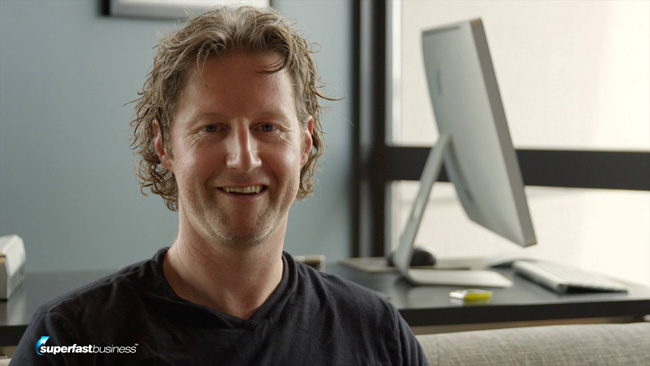

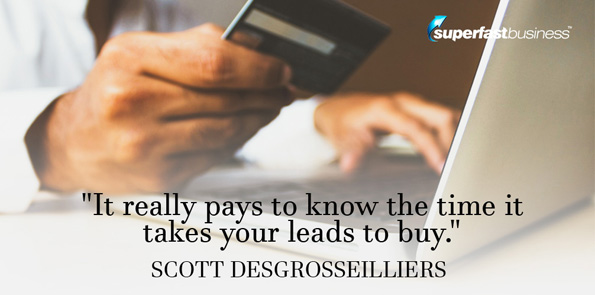


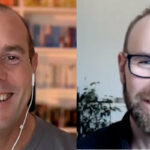






Leave a Reply